

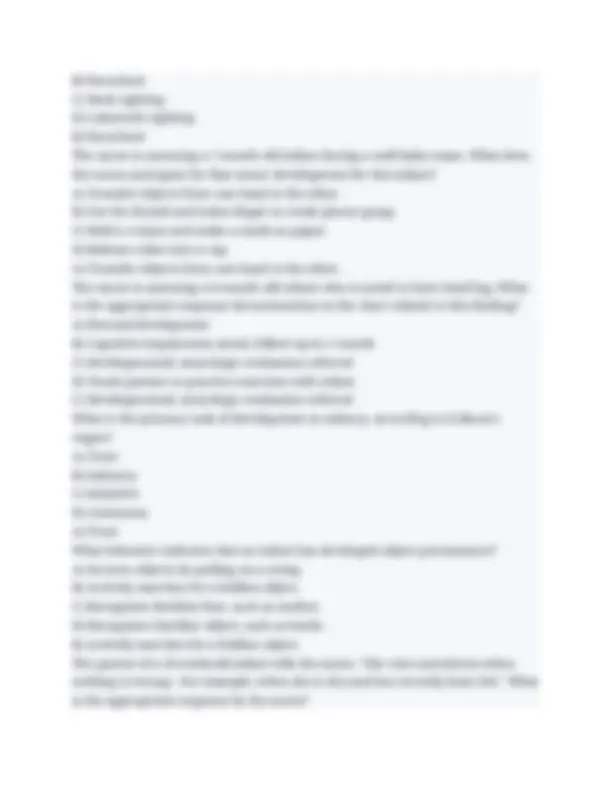
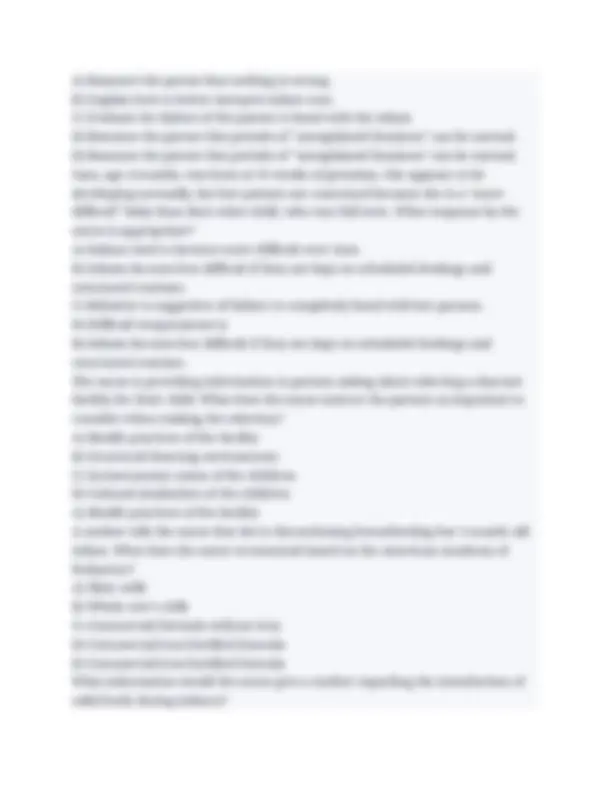
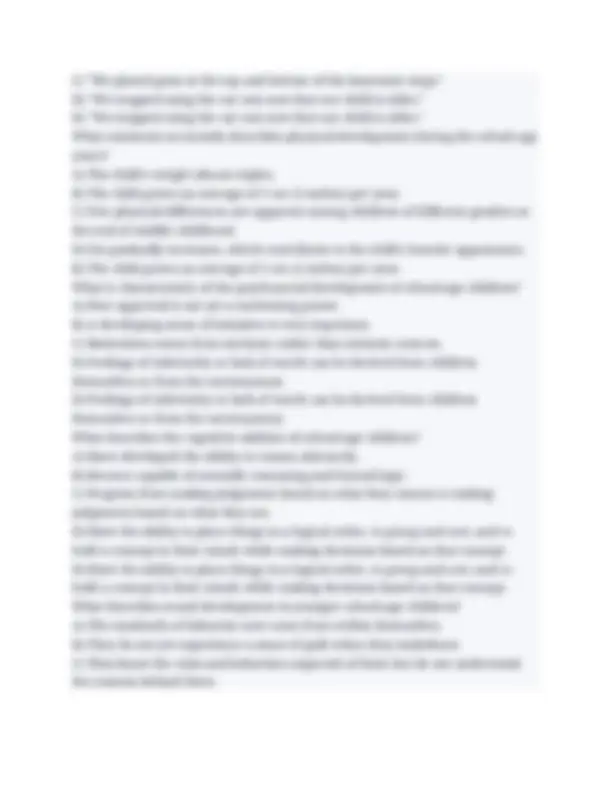
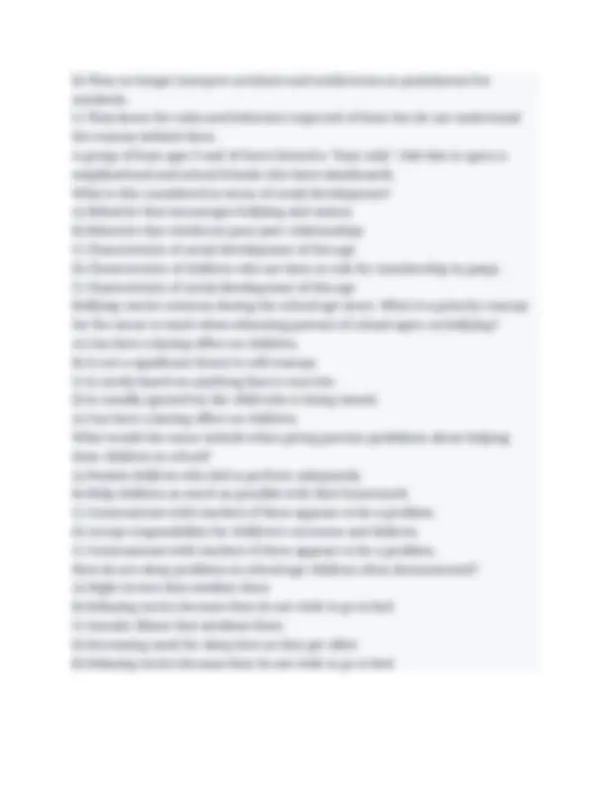

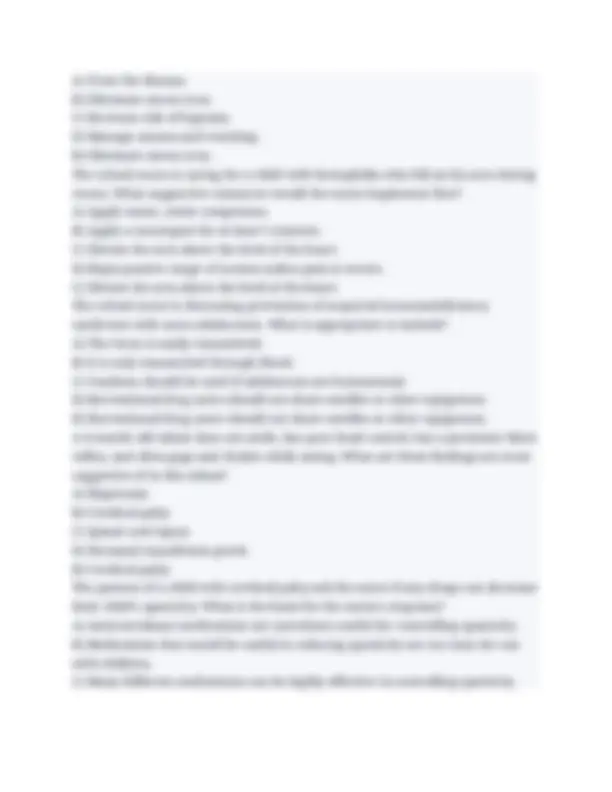
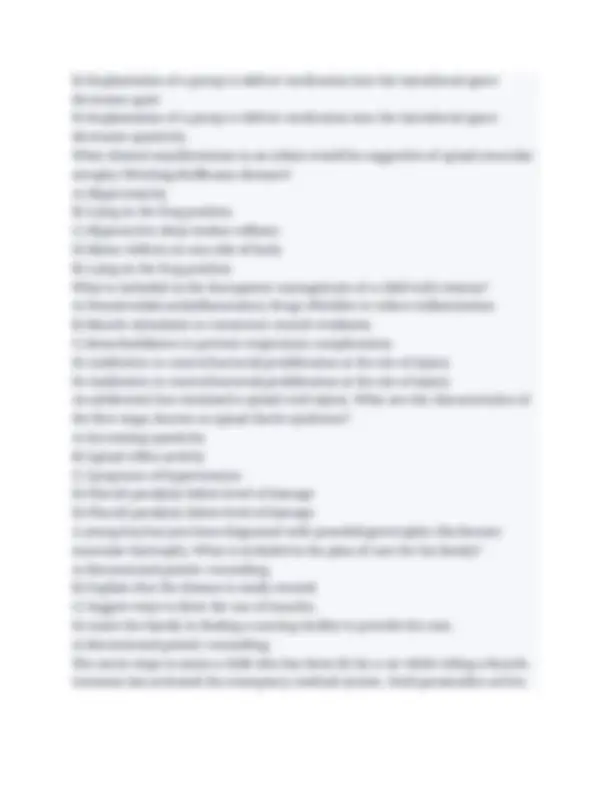
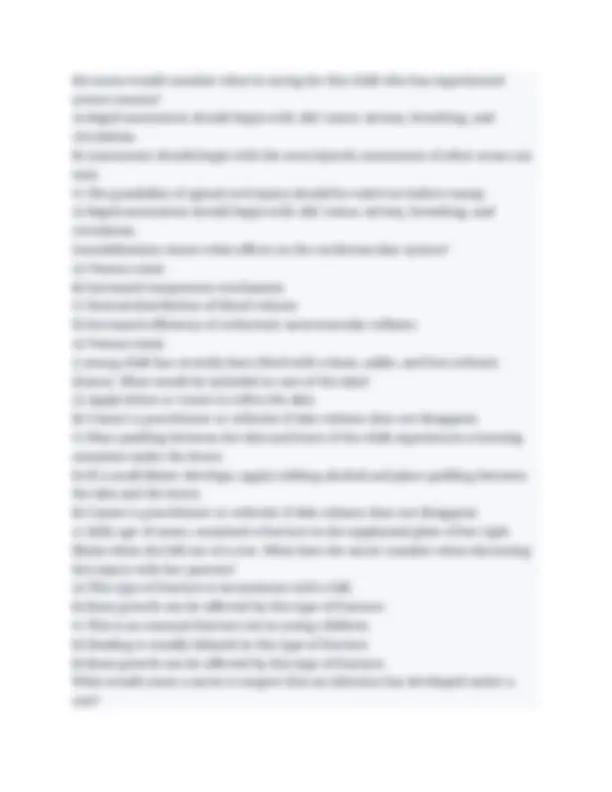


Study with the several resources on Docsity

Earn points by helping other students or get them with a premium plan


Prepare for your exams
Study with the several resources on Docsity

Earn points to download
Earn points by helping other students or get them with a premium plan
Community
Ask the community for help and clear up your study doubts
Discover the best universities in your country according to Docsity users
Free resources
Download our free guides on studying techniques, anxiety management strategies, and thesis advice from Docsity tutors
Hockenberry_ Evolve Resources for Wong's Nursing Care of Infants and Children, 11th Edition-NCLEX
Typology: Exams
1 / 17

This page cannot be seen from the preview
Don't miss anything!










What is the most critical physiologic change required of newborns at birth? A) Transition from fetal to neonatal breathing B) Body temperature maintenance C) Stabilization of fluid and electrolytes D) Closure of fetal shunts in the heart A) Transition from fetal to neonatal breathing Neonates are predisposed to problems with thermoregulation because of what factor? A) Renal function is not fully developed. B) Flexed posture favors heat loss. C) A large body surface area favors heat loss to the environment. D) A thick layer of subcutaneous fat provides excellent insulation. C) A large body surface area favors heat loss to the environment. Read More What is characteristic of a neonate's vision? A) Pupils react to light. B) Tear glands function. C) Blink reflex is absent. D) Ciliary muscles are mature. A) Pupils react to light.
What tools would be most useful to assess maternal and newborn attachment behaviors? A) Apgar B) Ballard scale C) NCAST (Nursing Child Assessment Satellite Training) Feeding Scale D) Brazelton Neonatal Behavioral Assessment Scale C) NCAST (Nursing Child Assessment Satellite Training) Feeding Scale The nurse is assessing a 3-day-old breastfed newborn who weighed 3400 g ( pounds, 8 oz) at birth. The infant's mother is now concerned because the infant weighs 3147 g (6 pounds, 15 oz). The most appropriate nursing intervention is what? A) Recommend supplemental feedings of formula. B) Explain that this weight loss is within normal limits. C) Assess the child further to determine the cause of excessive weight loss. D) Encourage the mother to express breast milk for bottle-feeding the infant. B) Explain that this weight loss is within normal limits. Where would nonpathologic cyanosis normally be present in the newborn shortly after birth? A) Feet and hands B) Bridge of nose C) Circumoral area D) Mucous membranes A) Feet and hands What findings on physical assessment of a neonate would indicate the need for further evaluation? A) Nystagmus B) Epstein pearls C) Low-set ears D) Positive Babinski reflex C) Low-set ears What findings would the nurse consider normal in assessing the anterior fontanel of a neonate? A) Closed anterior fontanel B) Sunken anterior fontanel
B) Parachute C) Neck righting D) Labyrinth righting B) Parachute The nurse is assessing a 7-month old infant during a well baby exam. What does the nurse anticipate for fine motor development for this infant? A) Transfer objects from one hand to the other. B) Use the thumb and index finger in crude pincer grasp. C) Hold a crayon and make a mark on paper. D) Release cubes into a cup. A) Transfer objects from one hand to the other. The nurse is assessing a 6-month-old infant who is noted to have head lag. What is the appropriate response documentation in the chart related to this finding? A) Normal development B) Cognitive impairment noted, follow-up in 1 month C) Developmental, neurologic evaluation referral D) Teach parents to practice exercises with infant C) Developmental, neurologic evaluation referral What is the primary task of development in infancy, according to Erikson's stages? A) Trust B) Industry C) Initiative D) Autonomy A) Trust What behavior indicates that an infant has developed object permanence? A) Secures objects by pulling on a string. B) Actively searches for a hidden object. C) Recognizes familiar face, such as mother. D) Recognizes familiar object, such as bottle. B) Actively searches for a hidden object. The parent of a 10-week-old infant tells the nurse, "She cries sometimes when nothing is wrong—for example, when she is dry and has recently been fed." What is the appropriate response by the nurse?
A) Reassure the parent that nothing is wrong. B) Explain how to better interpret infant cues. C) Evaluate for failure of the parent to bond with the infant. D) Reassure the parent that periods of "unexplained fussiness" can be normal. D) Reassure the parent that periods of "unexplained fussiness" can be normal. Sara, age 4 months, was born at 35 weeks of gestation. She appears to be developing normally, but her parents are concerned because she is a "more difficult" baby than their other child, who was full term. What response by the nurse is appropriate? A) Infants tend to become more difficult over time. B) Infants become less difficult if they are kept on scheduled feedings and structured routines. C) Behavior is suggestive of failure to completely bond with her parents. D) Difficult temperament is B) Infants become less difficult if they are kept on scheduled feedings and structured routines. The nurse is providing information to parents asking about selecting a daycare facility for their child. What does the nurse instruct the parents as important to consider when making the selection? A) Health practices of the facility B) Structured learning environment C) Socioeconomic status of the children D) Cultural similarities of the children A) Health practices of the facility A mother tells the nurse that she is discontinuing breastfeeding her 5-month-old infant. What does the nurse recommend based on the American Academy of Pediatrics? A) Skim milk B) Whole cow's milk C) Commercial formula without iron D) Commercial iron-fortified formula D) Commercial iron-fortified formula What information would the nurse give a mother regarding the introduction of solid foods during infancy?
D) Understand the passage of time, such as "just a minute" and "in an hour." A) Realize that "out of sight" is not out of reach. Two toddlers are playing in a sandbox when one child suddenly grabs a toy from the other child. What is the best interpretation of this behavior? A) This is typical behavior because toddlers are aggressive. B) This is typical behavior because toddlers are egocentric. C) Toddlers should know that sharing toys is expected of them. D) Toddlers should have the cognitive ability to know right from wrong. B) This is typical behavior because toddlers are egocentric. A toddler's parent asks the nurse for suggestions on dealing with temper tantrums. What is the most appropriate recommendation? A) Punish the child. B) Explain to the child why the tantrum is wrong. C) Leave the child alone until the tantrum is over. D) Remain close by the child but ignore the behaviors. D) Remain close by the child but ignore the behaviors. What statement characterizes toddlers' eating behavior? A) Food fads are common. B) They have increased appetite. C) They have few food preferences. D) Their table manners are predictable. A) Food fads are common. What is not an appropriate recommendations for parents of toddlers to meet fluoride requirements? A) Supervise the use of toothpaste. B) Supervise the use of fluoride rinses. C) Store fluoride products out of reach. D) Administer fluoride supplements if water fluoride content is low. B) Supervise the use of fluoride rinses. A parent has a 2-year-old child in the clinic for a well-child checkup. What statement by the parent would indicate to the nurse that the parent needs more instruction regarding accident prevention? A) "We locked all the medicines in the bathroom cabinet." B) "We turned the thermostat down on our hot water heater."
C) "We placed gates at the top and bottom of the basement steps." D) "We stopped using the car seat now that our child is older." D) "We stopped using the car seat now that our child is older." What statement accurately describes physical development during the school-age years? A) The child's weight almost triples. B) The child grows an average of 5 cm (2 inches) per year. C) Few physical differences are apparent among children of different genders at the end of middle childhood. D) Fat gradually increases, which contributes to the child's heavier appearance. B) The child grows an average of 5 cm (2 inches) per year. What is characteristic of the psychosocial development of school-age children? A) Peer approval is not yet a motivating power. B) A developing sense of initiative is very important. C) Motivation comes from extrinsic rather than intrinsic sources. D) Feelings of inferiority or lack of worth can be derived from children themselves or from the environment. D) Feelings of inferiority or lack of worth can be derived from children themselves or from the environment. What describes the cognitive abilities of school-age children? A) Have developed the ability to reason abstractly. B) Become capable of scientific reasoning and formal logic. C) Progress from making judgments based on what they reason to making judgments based on what they see. D) Have the ability to place things in a logical order, to group and sort, and to hold a concept in their minds while making decisions based on that concept. D) Have the ability to place things in a logical order, to group and sort, and to hold a concept in their minds while making decisions based on that concept. What describes moral development in younger school-age children? A) The standards of behavior now come from within themselves. B) They do not yet experience a sense of guilt when they misbehave. C) They know the rules and behaviors expected of them but do not understand the reasons behind them.
The parents of an 8-year-old girl tell the nurse that their daughter wants to join a soccer team. What information does the nurse provide regarding participation in sports at this age? A) Organized sports such as soccer are not appropriate at this age. B) Competition is detrimental to the establishment of a positive self-image. C) Sports participation is encouraged if the type of sport is appropriate to the child's abilities. D) Girls should compete only against girls because at this age boys C) Sports participation is encouraged if the type of sport is appropriate to the child's abilities. The school nurse is teaching dental health to a class of first graders. What would be included in the teaching? A) Teach how to floss teeth properly. B) Recommend a toothbrush with hard nylon bristles. C) Emphasize the importance of brushing before bedtime. D) Recommend nonfluoridated toothpaste approved by the American Dental Association. C) Emphasize the importance of brushing before bedtime. The school nurse is discussing testicular self-examination with adolescent male students. Why is this important? A) Epididymitis is common during adolescence. B) Asymptomatic sexually transmitted infections may be present. C) Testicular tumors during adolescence are generally malignant. D) Testicular tumors, although usually benign, are common during adolescence. C) Testicular tumors during adolescence are generally malignant. An adolescent asks the nurse what causes primary dysmenorrhea. What information does the nurse include in her response? A) It is an inherited problem. B) Excessive estrogen production causes uterine pain. C) There is no physiologic cause; it is a psychologic reaction. D) One factor is the onset of ovulatory cycles. D) One factor is the onset of ovulatory cycles.
An adolescent tells the school nurse that she is pregnant. Her last menstrual period was 4 months ago. She has not received any medical care. She smokes but denies any other substance use. What is the priority nursing action? A) Notify her parents. B) Refer her for prenatal care. C) Explain the importance of not smoking. D) Discuss dietary needs for adequate fetal growth. B) Refer her for prenatal care. What does the nurse take into consideration when planning sex education and contraceptive teaching for adolescents? A) Both sexual activity and contraception require planning. B) Teenagers frequently lack a fundamental understanding of fertility. C) Most teenagers today are knowledgeable about reproductive anatomy and physiology. D) Most teenagers who become pregnant do so as an act of hostility, especially toward their parents. B) Teenagers frequently lack a fundamental understanding of fertility. The nurse is explaining blood components to an 8-year-old child. What is the nurse's best description and action of platelets? A) Make up the liquid portion of blood. B) Help keep germs from causing infection. C) Carry the oxygen you breathe from your lungs to all parts of your body. D) Help your body stop bleeding by forming a clot (scab) over the hurt area. D) Help your body stop bleeding by forming a clot (scab) over the hurt area. What is the cause for the signs and symptoms when hemoglobin falls sufficiently to produce clinical manifestations? A) Phagocytosis B) Tissue hypoxia C) Pulmonary hypertension D) Depressed bone marrow B) Tissue hypoxia The nurse suspects a child is having an adverse reaction to a blood transfusion. What is the initial action by the nurse? A) Notify the physician.
A) Treat the disease. B) Eliminate excess iron. C) Decrease risk of hypoxia. D) Manage nausea and vomiting. B) Eliminate excess iron. The school nurse is caring for a child with hemophilia who fell on his arm during recess. What supportive measures would the nurse implement first? A) Apply warm, moist compresses. B) Apply a tourniquet for at least 5 minutes. C) Elevate the arm above the level of the heart. D) Begin passive range of motion unless pain is severe. C) Elevate the arm above the level of the heart. The school nurse is discussing prevention of acquired immunodeficiency syndrome with some adolescents. What is appropriate to include? A) The virus is easily transmitted. B) It is only transmitted through blood. C) Condoms should be used if adolescents are homosexual. D) Recreational drug users should not share needles or other equipment. D) Recreational drug users should not share needles or other equipment. A 6-month-old infant does not smile, has poor head control, has a persistent Moro reflex, and often gags and chokes while eating. What are these findings are most suggestive of in this infant? A) Hypotonia B) Cerebral palsy C) Spinal cord injury D) Neonatal myasthenia gravis B) Cerebral palsy The parents of a child with cerebral palsy ask the nurse if any drugs can decrease their child's spasticity. What is the basis for the nurse's response? A) Anticonvulsant medications are sometimes useful for controlling spasticity. B) Medications that would be useful in reducing spasticity are too toxic for use with children. C) Many different medications can be highly effective in controlling spasticity.
D) Implantation of a pump to deliver medication into the intrathecal space decreases spast D) Implantation of a pump to deliver medication into the intrathecal space decreases spasticity. What clinical manifestations in an infant would be suggestive of spinal muscular atrophy (Werdnig-Hoffmann disease)? A) Hypertonicity B) Lying in the frog position C) Hyperactive deep tendon reflexes D) Motor deficits on one side of body B) Lying in the frog position What is included in the therapeutic management of a child with tetanus? A) Nonsteroidal antiinflammatory drugs (NSAIDs) to reduce inflammation B) Muscle stimulants to counteract muscle weakness C) Bronchodilators to prevent respiratory complications D) Antibiotics to control bacterial proliferation at the site of injury D) Antibiotics to control bacterial proliferation at the site of injury An adolescent has sustained a spinal cord injury. What are the characteristics of the first stage, known as spinal shock syndrome? A) Increasing spasticity B) Spinal reflex activity C) Symptoms of hypertension D) Flaccid paralysis below level of damage D) Flaccid paralysis below level of damage A young boy has just been diagnosed with pseudohypertrophic (Duchenne) muscular dystrophy. What is included in his plan of care for his family? A) Recommend genetic counseling. B) Explain that the disease is easily treated. C) Suggest ways to limit the use of muscles. D) Assist the family in finding a nursing facility to provide his care. A) Recommend genetic counseling. The nurse stops to assist a child who has been hit by a car while riding a bicycle. Someone has activated the emergency medical system. Until paramedics arrive,
A) Cold toes B) Increased respirations C) Complaint of paresthesia D) "Hot spots" felt on the cast surface D) "Hot spots" felt on the cast surface What statement is correct regarding sports injuries during adolescence? A) Rapidly growing bones, muscles, joints, and tendons offer some protection from unusual strain. B) The increase in strength and vigor during adolescence helps prevent injuries related to fatigue. C) More injuries occur during organized athletic competition than during recreational sports participation. D) Adolescents may not possess the insight and judgment to recognize when an activity is beyond their capabilities. D) Adolescents may not possess the insight and judgment to recognize when an activity is beyond their capabilities. What results when ice is applied immediately after a soft tissue injury, such as a sprained ankle? A) Increases the pain threshold. B) Increases metabolism in the tissues. C) Produces deep tissue vasodilation. D) Leads to release of more histamine-like substances. C) Produces deep tissue vasodilation. A 4-year-old child is newly diagnosed with Legg-Calvé-Perthes disease. Nursing considerations include what? A) Encourage normal activity for as long as possible. B) Explain the cause of the disease to the child and family. C) Prepare the child and family for long-term, permanent disabilities. D) Teach the family the care and management of the corrective appliance. D) Teach the family the care and management of the corrective appliance. The nurse is preparing an adolescent girl for surgery to treat scoliosis. What would the nurse include? A) Blood administration may be an option. B) Ambulation will not be allowed for up to 3 months.
C) Surgery eliminates the need for casting and bracing. D) Discomfort can be controlled with nonpharmacologic methods. A) Blood administration may be an option. What is an important nursing consideration when caring for a child with juvenile idiopathic arthritis? A) Apply ice packs to relieve stiffness and pain. B) Administer acetaminophen to reduce inflammation. C) Teach the child and family the correct administration of medications. D) Encourage range of motion exercises during periods of inflammation. C) Teach the child and family the correct administration of medications.